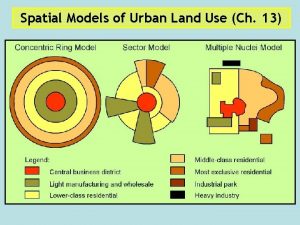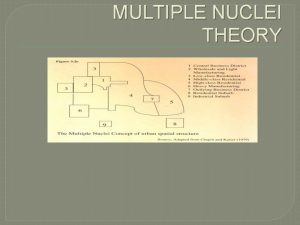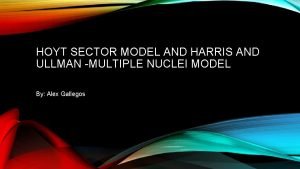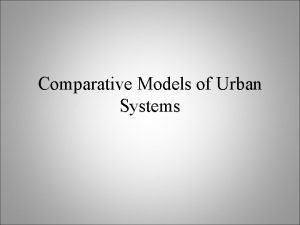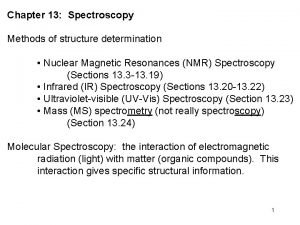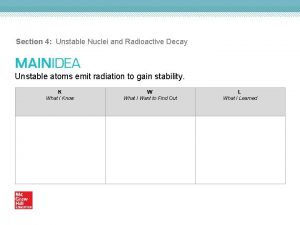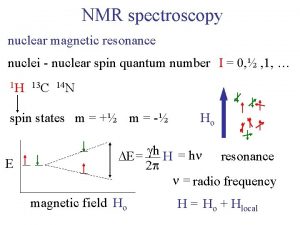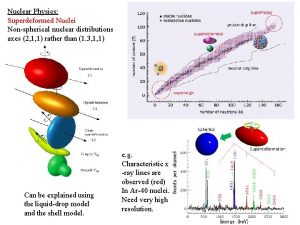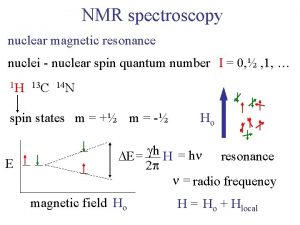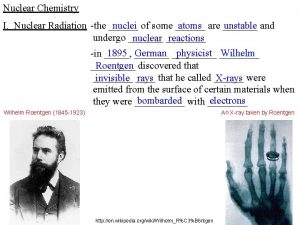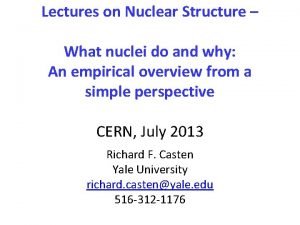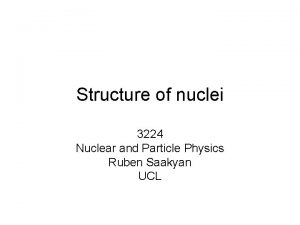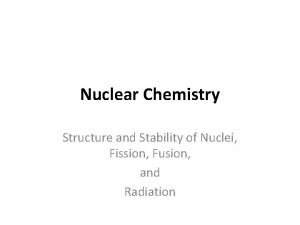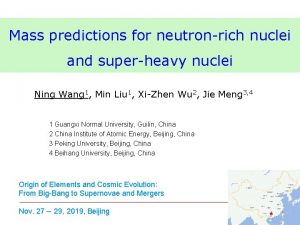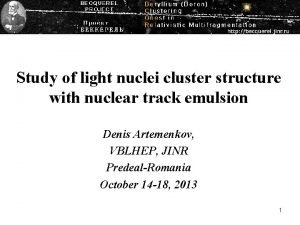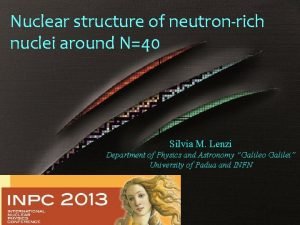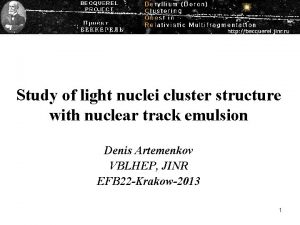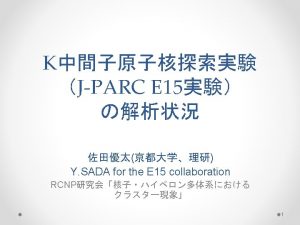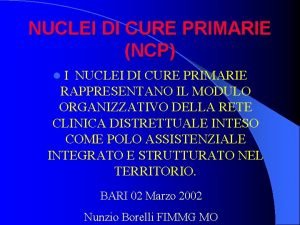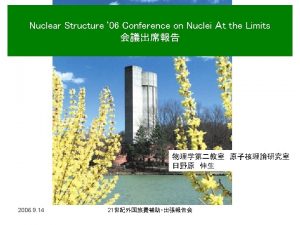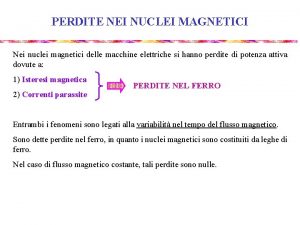NUCLEAR STRUCTURE AND GENERAL POPERTIES OF NUCLEI The













































- Slides: 45

NUCLEAR STRUCTURE AND GENERAL POPERTIES OF NUCLEI

The nucleus of an atom is abound quantum system and hence can exist in different quantum states characterized by their energies , angular momenta etc. the lowest energy state is known as as the ground state and the nuclei normally exist in this state , the properties of the nuclei which will be discussed correspond to their ground states and are usually called their static properties in contrast to the dynamic characteristics of the nuclei which are exhibited in the processes of nuclear reactions, nuclear excitations and nuclear decay. The important static properties of the nuclei include their electric charge , mass, binding energy, size , shape, angular momentum , magnetic dipole moment, electric quadruple moment, statistics, parity, and iso-spin. We will discuss these properties Insha'Allah during this semester.

NUCLEAR MASS AND BINDING ENERGY

ATOMS AND ISOTOPES

The atomic nuclei are made up of two different types of elementary particles, protons &neutrons. Proton (p) has positive charge(+e) and a mass about 1836 times the electronic mass me . Neutrons (n) is electrically neutral and is slightly heavier than the protons. The protons and the neutrons are held together inside the nucleus by very strong short range attractive force. this force is different from the more commonly known forces like the gravitational or electrical forces and constitutes what may be called the specifically nuclear interaction. The protons and the neutrons are jointly known as the nucleons.

MASS NUMBER AND ATOMIC NUMBER The sum of the numbers of protons(Z) and the neutrons(N) inside the nucleus is known as its mass number A, so that A= Z+N. Obviously A is an integer just as N and Z is equal to the atomic number of the element in the periodic table. A nucleus of an atom X of an atomic number Z and mass number A is symbolically written as , for example denotes the nucleus of the helium atom of atomic number 2 and mass number 4, this is actually Alfa particle. the subscript to the left of the atomic number is often omitted , so that we can write .

ISOTOPES Nuclei with the same Z, but different A are called isotopes. A particular element with a given Z may have isotopes of different mass numbers. Their nuclei contain the same number of protons and different number of neutrons. Isotopes were first discovered amongst naturally radioactive elements J. J. Thomson while exploring the properties of positive rays by the parabola method, was the first to discover stable isotopes of neon (Z=10), viz. , 20 Ne and 22 Ne. many elements have more than one stable isotope. Elements having more than one stable isotope in the natural state are mixtures of these isotopes in fixed proportions, known as their relative abundances.

Nuclei with the same A, but different Z are called isobars , while nuclei with the same number of n are known as isotones

BINDING ENERGY In nuclear physics we are concerned with the masses of the nuclei , experimental determination using mass spectroscopes yield the atomic masses. Hence in all tables , it is the atomic masses shown not the nuclear masses. The nuclear mass Mnuc. is obtained from the atomic mass M by subtracting the masses of Z orbital electrons from the latter. This expression is not exact, since it does not take into account the binding energies of the electrons in the atom. However the error due to this is very small and hence in all numerical calculations involving the nuclear processes , it is the atomic masses which are used, since the electronic masses usually cancel out.

The nuclei of the atoms are very strongly bound. It requires energies of the order of a few million electron volts (Me. V) to break away a nucleon from a nucleus compared to only a few electron volts to detach an orbital electron from an atom to ionize it. (in the case of hydrogen atom this ionization energy is 13. 6 e. V. ). If we want to break up a nucleus of Z protons and N neutrons completely so that they are separated from one another, A certain minimum amount of energy is to be supplied to the nucleus. this energy is known as binding energy of the nucleus. Conversely if we start with Z protons and N neutrons at rest , all completely separated from one another , and then bring these together to constitute the nucleus of mass number A=Z+N and nuclear charge Z, then an amount of energy equal to the binding energy of the nucleus will be evolved. let us see what the source of this energy is.


According to the special theory of relativity propounded by Albert Einstein, mass and energy are equivalence. The mass of a body can be transformed into energy in certain physical and chemical processes, and vice-versa. The mass m of a body is completely converted into energy, produces an equivalent amount of energy mc 2 where is c is the velocity of light in vacuum c=2. 997925× 108 m/s. Thus 1 g when completely converted into energy gives 9× 1013 joules of energy.

In the case of formation of nucleus the evolution of energy equal to the binding energy of the nucleus takes places due to the disappearance of a fraction of the total mass of the Z protons and N neutrons , out which the nucleus is formed. If the quantity of mass disappearing is ΔM , then the binding energy is (1 -1)

From the above discussion, it is clear that the mass of the nucleus must be less than the sum of the masses of the constituent neutrons and protons. Denoting the masses of the hydrogen atom and the neutrons as MH and Mn , we can then write (1 -2) Where M(A, Z) is the mass of the of atom mass number A and atomic number Z. hence the binding energy of the nucleus is (1 -3) The masses of electrons is cancelled out and then the masses of Z protons ZMp and N neutrons NMn minus the nucleus mass Mnuc. of atom.

And may be noted because of the mass-energy equivalence, the masses of atoms can be expressed in energy units , so c 2 in r. h. s. may be omitted.

The unit of atomic mass is defined to be (1/12) of the mass of the atom 12 C taken to be exactly 12 units and is designated by the symbol "u" (unified atomic mass unit), this unit has been in use since 1961 by both physicists and chemists by international agreement Prior to 1961, the atomic mass units used by physicists and chemists were different. The physicists’ unit was previously taken to be one-sixteenth of the mass of 16 O isotope (taken to be exactly 16 units) and was called the atomic mass unit (amu). The Conversion factor from one scale to the other is given by 1 u : I amu = 1. 0003172 : 1 1 u = 1. 660566× 10 -27 kg =931. 502 Mev The atomic mass unit previously used by the chemists, on the other hand, was one-sixteenth of the average atomic weight of natural oxygen consisting of the three isotopes 16 O, 17 O and 18 O having the relative abundances 99. 76% , 0. 04% and 0. 20% respectively.

2. 3 IMPORTANCE OF ACCURATE DETERMINATION OF ATOMIC MASSES Atomic masses can be determined with accuracies better than one part in a million by modern mass spectroscopes. Such great accuracies are needed for the determination of nuclear binding energies and in the calculation of nuclear disintegration energies.

SYSTEMATIC OF BINDING ENERGY

Accurate determination of the atomic masses shows that these are very close of whole numbers. Either in 12 C or 16 O. Mass defect is The difference between M and A For very light atoms A<20 and for very heavy atoms A>180 ΔM is slightly greater than the corresponding mass number Between the above values of A , ΔM is slightly less than the corresponding mass number.

PACKING FRACTION Packing fraction f The mass defect of an atom divided by its mass number packing fraction has the same sign of mass defect



From the figure it is seen that f varies in a systematic manner with the mass number A For very light nuclei and very heavy nuclei f is positive (20>A>180) For nuclei with mass numbers between 20 and 180 , f is negative

BINDING FRACTION FB If the binding energy EB of a nucleus divided by the mass number A , we get the binding energy per nucleon in the nucleus which is known as binding fraction f. B Here we assumed that the masses are expressed in energy unit so that c 2 has been omitted. Binding fraction f. B of different nuclei represent relative strength of their binding


IMPORTANT POINTS ABOUT FB 1. 2. 3. 4. f. B For very light nuclei is very small and rises rapidly with A attaining the value of 8 Me. V/nucleon for A~20, then it rises slowly with attains 8. 7 Me. V/nucleon for at A~56 for higher it decreases slowly For 20<A<180 the variation of f. B is very slight and it may be constant in this region having a mean value 8. 5 Me. V/nucleon For very heavy nuclei A>180 f. B decreases with the increase of A , for heaviest nuclei f. B is about 7. 5 Me. V/nucleon For very light nuclei there are rapid fluctuations in f. B , in particular for even-even nuclei for which A=4 n , n is an integer. similar but less prominent peaks are observed at values of Z or N=20, 28, 50, 82, 126 magic numbers, peaks means greater stability

We can write MH=1+f. H and Mn=1+fn , where f. H=0. 007825 u and fn=0. 008665 u

The first term on the r. h. s of latest eq. is almost constant specially for lower A when Z=N=A/2 So, we can see that binding fraction and packing fraction are proportional.

NUCLEAR SIZE 1. 2. Rutherford`s experiment of α-particle scattering gives us an idea about the smallness of the nuclear size, he estimated the values of nuclear radius R for a few light elements , these were of the order of a few times 10 -15 m, these values were not very accurate , in later years more accurate methods have been developed We assume that the nucleus has a spherical shape, this is expected because of the short range character for nuclear force . However small departures have been observed , this is inferred from the existence of electric quadruple moment of these nuclei which is zero for spherical nuclei, however it is small.

NUCLEAR CHARGE The nuclear charge has been uniformly distributed, experiments show that this is very nearly, so the nuclear charge density c is approximately constant, 2. experimental evidences also show that the distribution of nuclear matter is nearly uniform , so that the nuclear matter density m is also approximately constant, 3. since nuclear mass is almost linearly proportional to the mass number A, this mean m ~ A/V= constant , i. e. , the nuclear volume V=(4/3) R 3 ∝A R ∝ A 1/3 R= ro A 1/3 where ro is a constant known as 1. nuclear radius parameter

NUCLEAR RADIUS R Radius of the nuclear mass distribution , and we can talk about radius of nuclear charge distribution, since the nuclear charge parameter Z is almost proportional to the mass number A and the nuclear charge density c is approximately the same throughout nuclear volume V Due to the strong interaction the mass radius and charge radius may be expected to be very nearly

NUCLEAR SPIN 1. 2. Non relativistically moving nucleons have a spin ½. (i. e. sp=sn=1/2) in quantum mechanics the spin of p is represented by a vector operator Sp which have the Eigen values of And of � � And similarly for Sn. 3. In addition the nucleons may also have orbital angular momentum by virtue of their motion in the nucleus this is represented by an angular momentum quantum number L=0, 1, 2, ……. . for each nucleon �

4. The sum total of the spin and orbital angular momenta of the nucleons , the total intrinsic angular momentum of the nucleus is referred to as the nuclear spin and the associated quantum number is denoted by J=L+S, odd A nuclei have J=1/2, 3/2, 5/2, . . and even A nuclei have J=0, 1, 2…. . and this agrees with experimental measurements of nuclear spin , in addition it is found for even-even nuclei , the nuclear ground state spin is always J=0

THE STATISTICS TO WHICH NUCLEI ARE SUBJECTED The properties of protons, neutrons, and electrons (atomic nuclei) cannot be described on the basis of classical statistics, so, two new forms of statistics have been devised, based on quantum mechanics rather than on classical mechanics. There are the Bose-Einstein statistics and Fermi. Dirac statistics.

A nucleon is described by a function of its 3 space coordinates and the value of its spin. (1/2ћ or -1/2ћ) The Fermi- Dirac statistics apply to systems of particles for which the wave function of the systems is anti symmetrical I. e. It (changes sign when all of the coordinates of two identical particles are interchanged). It has been deduced from experiments that: All nuclei of odd mass no. (A) → obeys the Fermi-Dirac statistics. And all nuclei of even mass no. → obey the Bose-Einstein statistics.

THE PARITY The wave function of a nucleus may be expressed as the product of a function of the space coordinates and a function depending only on the spin orientation. The motion of the nucleus is said to have even parity if its wave function is unchanged when the space coordinates (x, y, z) are replaced by (-x, -y, -z). I. e. when the nucleus position is reflected about the origin of the x, y, z system of axis. The motion of the nucleus is said to have odd parity if the of its wave function is changed when the space coordinates (x, y, z) are replaced by (-x, y, -z)

THE PROTON-ELECTRON HYPOTHESIS OF THE CONSTITUTION OF THE NUCLEUS Prout: suggest that 1. all atomic weights must be integral multiples of the atomic weight of hydrogen and 2. all elements might be built up of hydrogen. But it was found that atomic weight of some elements are fractional as Cl , Cu. The idea that all elements are built up from one basic substance received supports after the discovery of isotopes.

Aston: formulate his whole numbers rule, which is modified from Prout's hypothesis. According to Aston's rule: “ 1. All atomic weights are very close to integers, and 2. the fractional atomic weights are caused by the presence of two or more isotopes each of which has a nearly integral atomic weight”. The combination of the whole number rule and the properties of the hydrogen nucleus lead to assumption that atomic nuclei are built up of hydrogen nuclei, and the hydrogen nucleus was given the name proton.

The proton-electron hypothesis of nucleus seemed to be consistent with the emission of α and β particles by the atoms of radioactive elements. The interpretation of radioactivity showed that both α and β particles were ejected from the nuclei of the atoms undergoing transformation and the presence of electrons in the nucleus made it seem reasonable under same conditions, one of them might be ejected. It was also assumed that the α-particle could be formed in the nucleus by the combination of four protons and two electrons.

THE ANGULAR MOMENTUM OF THE NUCLEUS; FAILURE OF THE PROTON – ELECTRON HYPOTHESIS: One of the failures of the hypothesis was associated with an unknown property of the nucleus, the angular momentum. or spin which is associated with a magnetic moment was a result of a detailed study of spectral lines. The splitting of a spectral line into a number of lines lying close together, is called hyperfine structure. The properties associated with the hyperfine structure are the mass and angular momentum of the nucleus.

The hyperfine structure can be accounted for quantitatively assuming that the nucleus has an angular momentum. The nuclear angular momentum is a vector, I, of magnitude |I|= sqrt [i(i+1)] h/2π Where i is the quantum number defines I According to the rule Iz = i h/2π The value of I has been found experimentally to depend on the mass number A of the nucleus. If A is even: I is an integer or 0, 1, 2, 3, … If A is odd: I is an odd half integral value 1/2, 3/2 , 5/2 , …. This rule leads to one of the failures of the protonelectron hypothesis.

EXAMPLE: 7 N 14 Atomic no. =7 , mass no. = 14 It's nucleus would have 14 protons and 7 electrons under this hypothesis. A =14 (even numbers) → The contribution of the protons to the angular momentum should be an integral multiple of h/2π. An electron has spin ½ћ so the contribution of 7 electrons is an odd half integral multiple of h/2π , and the total integral momentum of nitrogen nucleus should be an odd half - integral multiple of h/2π . But the angular momentum of nitrogen nucleus has been found experimentally to be I = 1 , an integer , In contradiction to the value obtained by the proton-electron hypothesis

THE DISCOVERY OF THE NEUTRON Rutherford in 1920 suggested that, an electron and proton might be so closely combined as to form a neutral particle which is given the name neutron. All the methods used for detection of P or e depend on the deflection of the charged particle So, it is difficult to detect the nº. Chadwick in 1932 demonstrated the existence of neutrons. This discovery led to presently accepted idea that the nucleus is built of protons and neutrons. 2 He 4 + 4 Be 9 → 6 C 12 + 0 n 1 Chadwick detected the neutrons, since these particles, unlike protons, produce no tracks in the cloud chamber and no ionization in the ionization chamber. These properties + the penetrating power of these particles show that the charge of these particles must be zero, and was identified as Rutherford's neutron.

THE PROTON-NEUTRON HYPOTHESIS The discovery of neutron, led to the assumption that every atomic nucleus consist of protons and neutrons. The neutron-proton hypothesis is consistent with the phenomena of radioactivity. Since there are several there reasons why electrons can not be present in the nucleus, it must be concluded that in β-radioactivity, the electron is created in the act of emission. i. e. as a result of a change of a neutron within the nucleus into a proton, an electron, and a new particle called neutrino. In free state they are unstable: n 0 P+ + -ve + (e-) An α particle can be formed by the combination of two protons and two neutrons. electrons.

NOTE: The neutron is not regarded as a composite system formed by a proton and an electron. The neutron is a fundamental particle in the same sense that the proton is. The two are sometimes called nucleons in order to indicate their function as the building blocks of nuclei.
 Lesson 15 nuclear quest nuclear reactions
Lesson 15 nuclear quest nuclear reactions Fisión nuclear vs fision nuclear
Fisión nuclear vs fision nuclear Harris peripheral model
Harris peripheral model Homer hoyt sector model
Homer hoyt sector model Multiple nuclei model date
Multiple nuclei model date Harris ullman model
Harris ullman model Multiple zone model
Multiple zone model Chauncy
Chauncy Nmr active and inactive nuclei
Nmr active and inactive nuclei How unstable atoms gain stability
How unstable atoms gain stability Hình ảnh bộ gõ cơ thể búng tay
Hình ảnh bộ gõ cơ thể búng tay Frameset trong html5
Frameset trong html5 Bổ thể
Bổ thể Tỉ lệ cơ thể trẻ em
Tỉ lệ cơ thể trẻ em Voi kéo gỗ như thế nào
Voi kéo gỗ như thế nào Tư thế worm breton
Tư thế worm breton Chúa sống lại
Chúa sống lại Các môn thể thao bắt đầu bằng tiếng đua
Các môn thể thao bắt đầu bằng tiếng đua Thế nào là hệ số cao nhất
Thế nào là hệ số cao nhất Các châu lục và đại dương trên thế giới
Các châu lục và đại dương trên thế giới Công của trọng lực
Công của trọng lực Trời xanh đây là của chúng ta thể thơ
Trời xanh đây là của chúng ta thể thơ Cách giải mật thư tọa độ
Cách giải mật thư tọa độ Làm thế nào để 102-1=99
Làm thế nào để 102-1=99 Phản ứng thế ankan
Phản ứng thế ankan Các châu lục và đại dương trên thế giới
Các châu lục và đại dương trên thế giới Thơ thất ngôn tứ tuyệt đường luật
Thơ thất ngôn tứ tuyệt đường luật Quá trình desamine hóa có thể tạo ra
Quá trình desamine hóa có thể tạo ra Một số thể thơ truyền thống
Một số thể thơ truyền thống Bàn tay mà dây bẩn
Bàn tay mà dây bẩn Vẽ hình chiếu vuông góc của vật thể sau
Vẽ hình chiếu vuông góc của vật thể sau Thế nào là sự mỏi cơ
Thế nào là sự mỏi cơ đặc điểm cơ thể của người tối cổ
đặc điểm cơ thể của người tối cổ Ví dụ về giọng cùng tên
Ví dụ về giọng cùng tên Vẽ hình chiếu đứng bằng cạnh của vật thể
Vẽ hình chiếu đứng bằng cạnh của vật thể Tia chieu sa te
Tia chieu sa te Thẻ vin
Thẻ vin đại từ thay thế
đại từ thay thế điện thế nghỉ
điện thế nghỉ Tư thế ngồi viết
Tư thế ngồi viết Diễn thế sinh thái là
Diễn thế sinh thái là Dạng đột biến một nhiễm là
Dạng đột biến một nhiễm là Số nguyên là gì
Số nguyên là gì Tư thế ngồi viết
Tư thế ngồi viết Lời thề hippocrates
Lời thề hippocrates Thiếu nhi thế giới liên hoan
Thiếu nhi thế giới liên hoan



